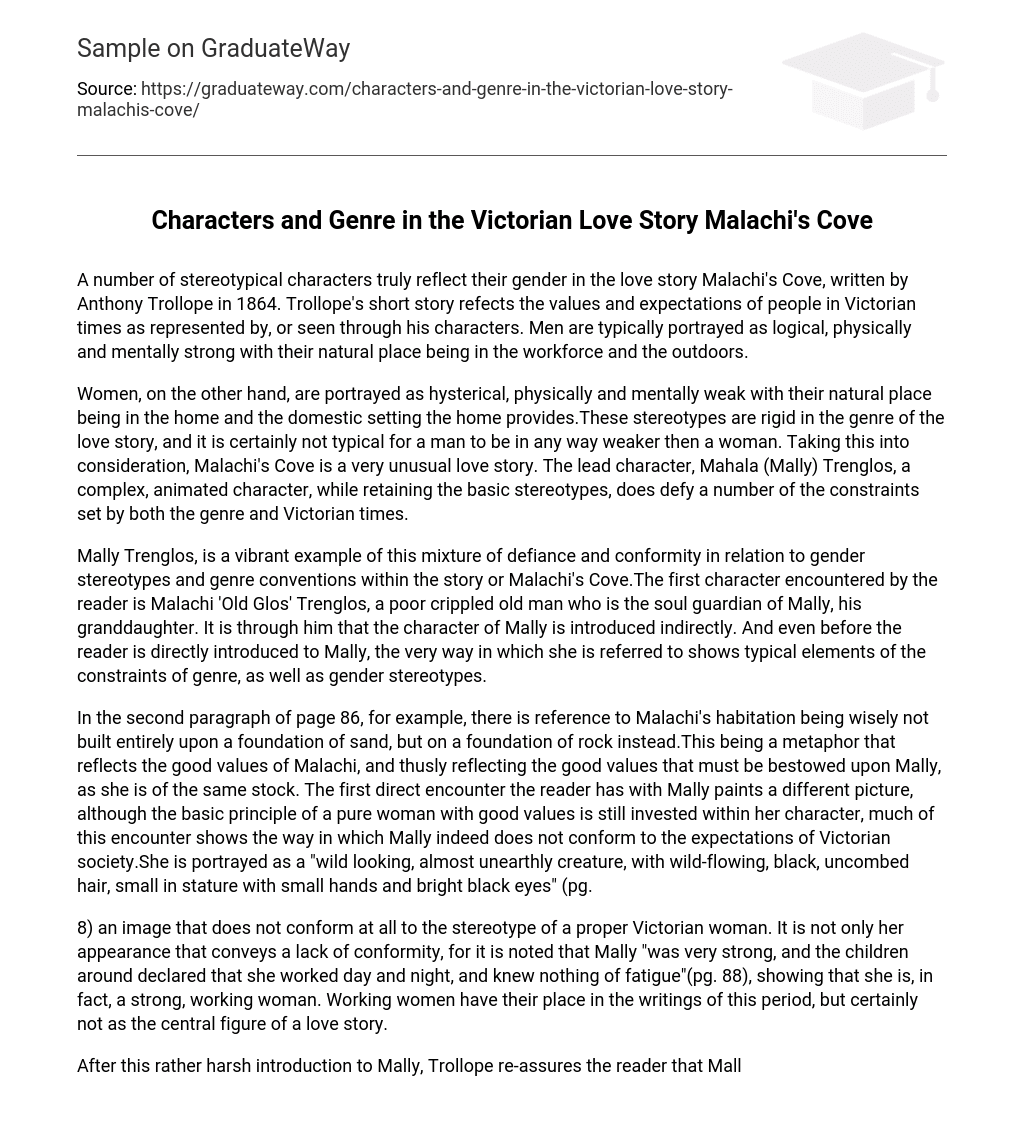A number of stereotypical characters in the love story Malachi’s Cove by Anthony Trollope in 1864 accurately depict their gender. Trollope’s short story showcases the Victorian values and expectations through his characters. The male characters are often depicted as rational, physically strong, and mentally formidable, primarily suited for work and outdoor activities.
Women are often depicted as hysterical, physically and mentally frail, and their expected role is confined to the home and domestic life. These stereotypes are especially rigid in love stories, where it is uncommon for men to be portrayed as weaker than women. However, Malachi’s Cove breaks from these conventions as an unconventional love story. The protagonist, Mahala (Mally) Trenglos, is a multifaceted and lively character who challenges many of the limitations imposed by both the genre and Victorian societal norms.
Mally Trenglos is a prime example of the blend of rebellion and compliance when it comes to gender norms and genre conventions in the narrative of Malachi’s Cove. The initial character encountered is Malachi ‘Old Glos’ Trenglos, an impoverished elderly man who serves as the sole protector of his granddaughter, Mally. This indirect introduction of Mally sheds light on her character through Malachi. Right from the start, the terminology used to refer to Mally exemplifies the constrains associated with genre and gender stereotypes.
On page 86, the second paragraph mentions Malachi’s habitation being wisely built on a foundation of rock instead of sand, serving as a metaphor for his good values. This metaphor applies to Mally as well since she comes from the same stock. However, the initial encounter with Mally presents a contrasting image. While her character still embodies the idea of a pure woman with good values, this encounter reveals that she does not conform to Victorian society’s expectations. Mally is described as a “wild looking, almost unearthly creature” with uncombed black hair, small stature, small hands, and bright black eyes (pg.).
8) The image does not conform to the stereotype of a proper Victorian woman. Mally’s appearance and strength convey her lack of conformity. It is noted that she works tirelessly and is unaffected by fatigue, which further emphasizes her strong work ethic. Although working women were featured in writings of this period, they were rarely portrayed as the main character in a love story.
After introducing Mally, Trollope assures the reader that she conforms to the genre’s constraints by mentioning how she only buys essentials for herself and her grandfather, including a small amount of gin and tobacco. This detail further establishes Mally as a good and pure-hearted character. However, this reassurance is short-lived as Mally defies not only stereotypes related to appearance and occupation but also the expectations of religious practice.
Despite some evidence of Mally’s awareness of her inappropriate attire in the church, as indicated by her pleading with the clergyman…
On page 89, it is mentioned that she doesn’t have appropriate clothes for church, indicating her disregard for Victorian society’s expectations. This is evident from the way she attends church, as described on page 9 – sitting on a stone bench in a short petticoat and with her hair untamed. Trollope has made an attempt to explain Mally’s behavior and nonconformity.
The primary reason for Mally’s justification is her isolation from society, both due to her lower social class and remote location. Additionally, her lack of a suitable role model, such as a mother or proper father figure, further contributes to her disregard for Victorian conventions. With only her grandfather as a moral compass, Mally is not taught the intricacies of Victorian society. Consequently, she is raised without the necessary knowledge to navigate societal norms. As an unconventional working-class woman excluded from mainstream society, it is expected that Mally’s future will be bleak. However, there is a small hope for her transformation in the character of Bartholomew ‘Barty’ Gunliffe.
Barty is a traditional male character in the love story genre, portrayed in a stereotypical manner. Initially, Barty is introduced as a morally upright character with physical features commonly associated with male characters in this genre (“Bartholomew Gunliffe was a very fine young fellow as far as the eye went. He was about five feet eight inches high, with strong arms and legs, with light curly brown hair and blue eyes..”).
“. Everybody liked Barty” (pg. 92). Initially, the reader sees Barty through Mally’s perspective, which still reflects her initial animosity towards him. However, despite this, the reader still views Barty as the archetypal good male character.
Trollope implies a sexual undertone in the relationship between Barty and Mally as they navigate their feelings for each other. The reader is not shocked when Mally eventually marries Barty, as Trollope subtly suggests this outcome. The reason for Mally being in the Gunliffe’s well-appointed farmhouse kitchen is clearly and explicitly stated.
Barty collects seaweed to support his family and also to gain control over Mally. However, the desire to master a woman can easily devolve into a desire for sexual intercourse. The narrator explains Barty’s motive by stating, “He would not let a girl defeat him” (pg 96). Despite Mally’s defiance of traditional gender roles in Victorian society, she ultimately still conforms to certain basic gender stereotypes.
She is initially a free, wild spirit, but her independence is eventually taken away by a man like Barty who chooses her to be his wife. She conforms to the traditional expectations of a Victorian woman, primarily because the story’s genre requires such an ending to conform to conventions. Changing the ending would have been too controversial for the time period in which it was written. Additionally, it was Mally who physically rescued Barty from drowning in the water, while Barty figuratively rescued Mally from a life of being an unconventional working-class woman, who would have been forced to live as a recluse away from society.





